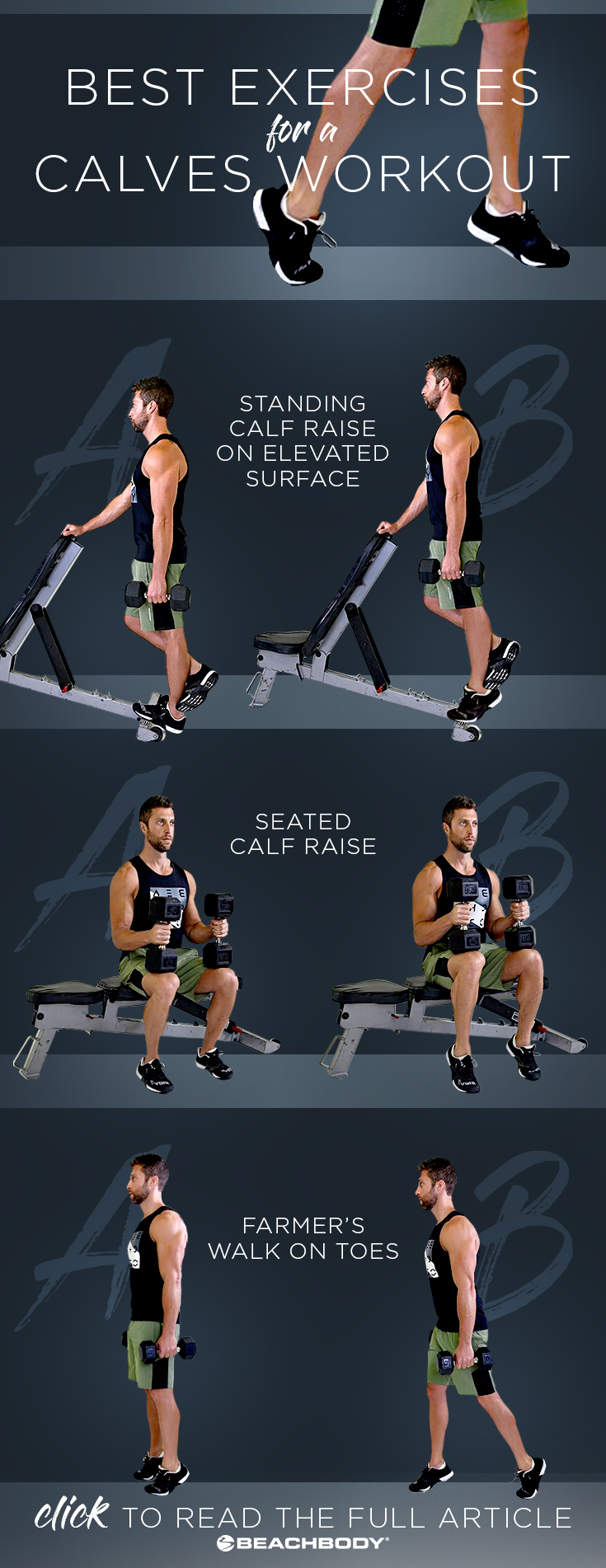Try These 8 Calf Exercises — Unless Your Legs Are Chicken

Have you ever seen the guys at the gym who have jacked upper bodies and bulging quads but celery stalks below the knees? It’s likely that they skimp on calves exercises in their workouts.
It can be easy to make these smaller muscles an afterthought, but strong calves don’t just help to balance out your appearance, they’re also key to gaining power and explosiveness both inside and outside the gym.
“Your calf muscles help propel you forward and up in explosive movements,” says Cody Braun, CSCS, NASM performance enhancement specialist.
This makes them very useful for fast-twitch exercises like sprinting and plyometrics, and any activity that requires leg propulsion or foot stabilization upon landing, like cycling, running, volleyball, or basketball.
Plus, tight calf muscles can limit your ankle mobility and potentially increase the probability of injuries like shin splints, plantar fasciitis, or Achilles tendonitis. So it’s crucial to train them — and work on ankle mobility — regularly.
Before you do that, however, it’s instructive to familiarize yourself the muscles of the calf and their overlapping functions.
Calf Muscle Anatomy
“The two main muscles you’re trying to build when doing calf exercises are the soleus and the gastrocnemius,” Braun says.
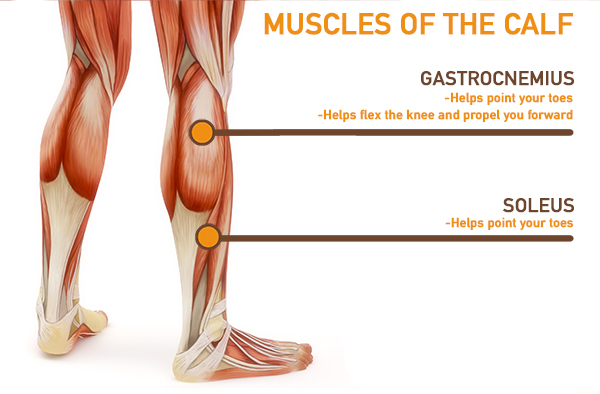
Gastrocnemius
The gastrocnemius is the main player in the muscle group that comprises your calves. If it’s highly developed, it will be thick and well-defined.
The gastroc is responsible for flexing (bending) the knee and pointing the foot, an action known as plantarflexion.
“The gastrocnemius muscle contributes to jumping, acceleration, and explosive speed and power,” says William P. Kelley, DPT, CSCS, ACT.
Soleus
The soleus, in contrast, isn’t outwardly visible — it’s situated deep beneath the gastrocnemius, and limited in function to plantarflexion.
“The soleus muscle contributes to walking and running endurance,” Kelley says.
You can emphasize either in your calves workout with a change in knee angle: Standing calf exercises will target the gastrocnemius, while seated calf raises favor the soleus.
Moral of the story: It’s important to make sure you target both in your calf workouts at home. Start with eight of the best calf exercises below.
8 of the Best Calf Exercises for Muscle Growth
You don’t have to go to a gym to train your calves — each of the following moves can blow up your lower legs at home. Drop one or more into your next leg day workout.
1. Standing calf raise
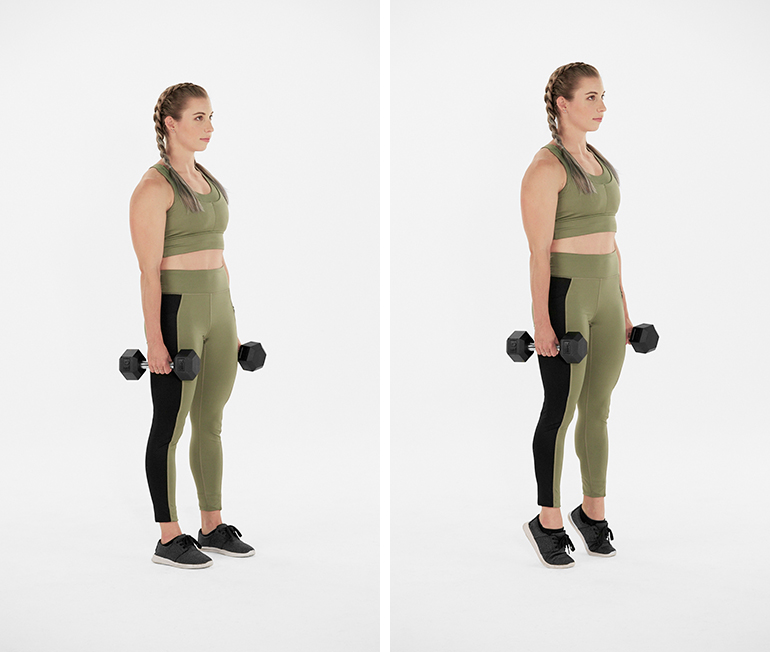
The standard calf raise can be performed just about anywhere. On top of strengthening your calf muscles, it also improves ankle strength and mobility, helps prevent injuries, and improves athletic performance.
- Stand with your feet flat on the floor, hip width apart, and toes facing forward. Option to hold a pair of dumbbells with your hands by your sides.
- Rise onto the balls of your feet, as high as you can.
- Pause at the top, squeezing your calf muscles, then lower your heels back down in a slow, controlled motion. Repeat as desired.
2. Single-Leg elevated calf raise
“This is a great exercise to stretch and strengthen the calves (primarily the gastrocnemius) through a full range of motion,” Kelley says.
- Holding a dumbbell in your left hand, stand with the ball of your left foot on an elevated surface with your heel hanging off, and your right toes resting on your left ankle.
- Keeping your core engaged, raise your left heel as high as possible.
- Slowly lower your heel down below the raised surface until you feel a stretch in your calf.
- Repeat and do equal reps on both legs.
3. Seated calf raise

“This exercise is great for soleus isolation,” Kelley says.
- Sit tall on a bench or chair with your feet flat on the ground holding two heavy dumbbells on top of your thighs.
- Keeping your core engaged, lift your heels off the ground as high as possible.
- Slowly lower your heels back down to the ground, and repeat.
To increase your range of motion and work your muscles even more while doing a seated calf raise, Kelley suggests elevating the balls of your feet with a block.
4. Farmer’s walk on toes
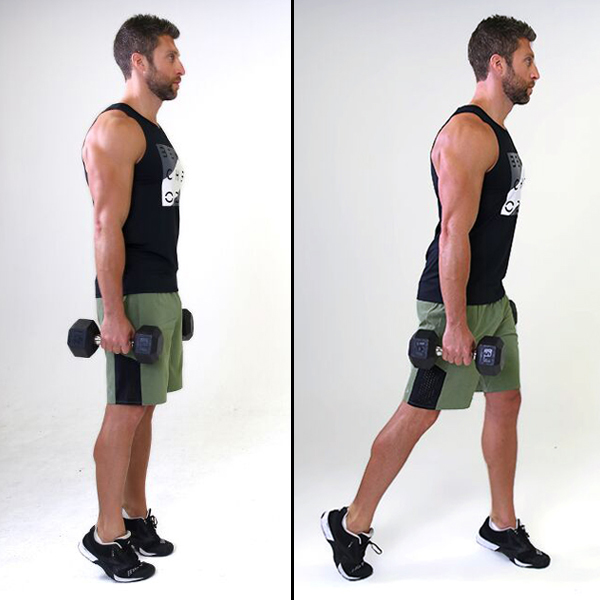
This variation on a traditional farmer’s walk is excellent for functional calf strengthening and balance, Kelley says.
- Hold a dumbbell in each hand with your feet hip-width apart.
- Keeping your shoulders down and your core engaged, lift your heels so you’re standing on your toes.
- Without letting your heels touch the ground, walk forward on your toes for a set number of reps or time.
5. Jump rope
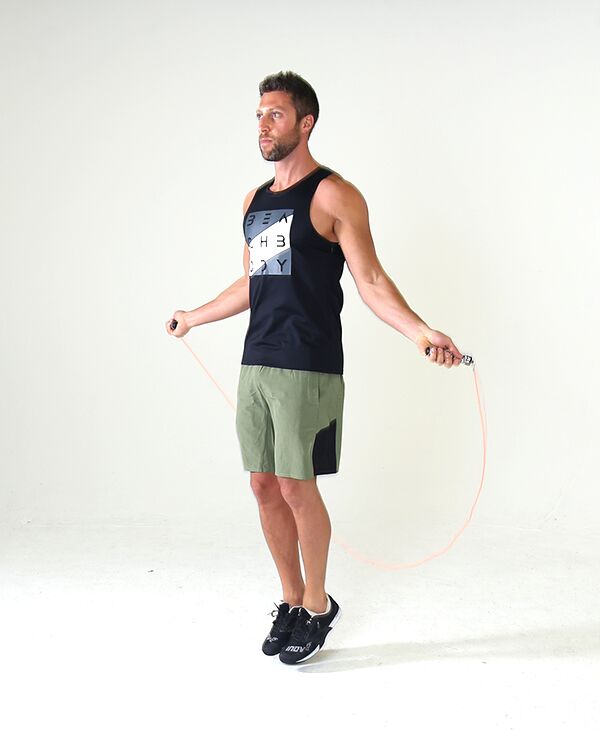
Jumping rope is a good bodyweight endurance exercise for your calves, and also helps improve total-body coordination, Kelley says.
- Holding the handles of a jump rope in each hand, jump with both feet as you spin the rope under you and over your head. Keep your core engaged and your shoulders lowered.
6. Dumbbell jump squat
This plyometric exercise gets power from the calf muscles during the ascension of the jump squat, Braun says, as well as stabilization during the landing.
- Holding a dumbbell in each hand, stand tall with your feet shoulder-width apart.
- Push your hips back to lower down until your thighs are parallel with the ground and you’re in squat position.
- In one explosive movement, straighten your legs to come out of the squat position and jump off the ground.
- Land softly with bent knees as you lower back into the squat position. Repeat.
7. Plyo lunge
You’ll use your calf muscles — along with your other leg muscles like the glutes and hamstrings — to power through this explosive plyometric move.
- Stand in a staggered stance with your right foot 2 to 3 feet in front of your left foot. Let your arms hang by your sides.
- Keeping your chest up, back straight, and core engaged, lower yourself into a lunge: front thigh parallel to the floor, rear knee bent to about 90 degrees.
- Jump straight up so that both feet leave the floor. Swing your arms if needed to optimize your momentum and power.
- Switch leg positions in the air, landing softly with your left foot forward.
- Immediately lower your body back into a lunge to begin your next rep.
- Continue alternating legs with each rep.
8. Donkey calf raise
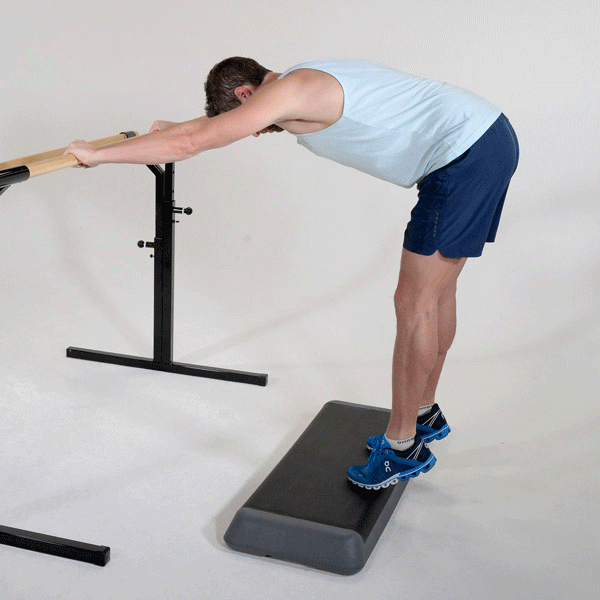
- Stand on a short step or weight plate with the balls of your feet on its far edge.
- Hinge forward at your waist so your back is flat, and hold onto an incline bench, rail, or sturdy chair around waist height using both hands.
- Without bending your knees, slowly lower your heels to the floor as far as possible, and then pause for a one-count.
- Lift your heels as high as possible, squeezing your calf muscles at the top of the move and holding for a one-count.
- Take a full three-count to lower your heels to the floor, and repeat.
How to Stretch Your Calves
“Daily calf stretching is a good habit to get into for greater calf extensibility,” Kelley says, “which will help with ankle mobility and more complex leg exercises, such as the squat.”
If tight calf muscles are limiting your ankle mobility, Braun recommends foam rolling in addition to stretching.
Aim to do both — foam rolling first, then stretching — after a leg-intensive workout. This will help relieve tension in your muscles and set you up for a quicker recovery.
1. Downward dog

The classic yoga pose is a great calf stretch.
- Begin in a tabletop position with your hands planted on the ground beneath your shoulders and your knees below your hips.
- Pressing firmly into your palms, tuck your toes, lift your knees off the ground, and slowly extend your hips upward.
- Without locking your knees, carefully straighten your legs until your body creates a triangle shape with the ground.
- Remember to engage your core as you continue to lengthen your spine and lift your hips as high as possible.
- To deepen the stretch, bend one knee and then the other to peddle the feet.
2. Straight-leg calf stretch against wall

This is a good stretch to target your gastrocnemius and simultaneously improve ankle flexibility, Braun says.
- Standing arm’s distance away from a wall, step one foot back and slightly bend your front knee.
- Lean forward to push your hands against the wall, and press your back heel down into the ground for a deep stretch. Make sure your leg is straight.
- Switch legs and repeat.
- To isolate the soleus, try a variation with your back leg slightly bent.
3. Standing wall calf stretch
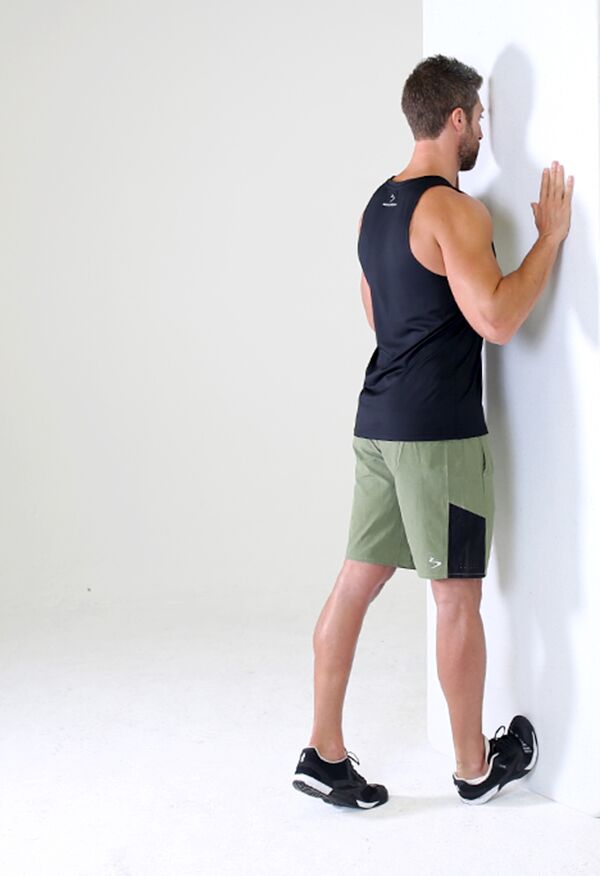
Another wall stretch variation, this hits your gastrocnemius and can also help relieve tension in your Achilles tendon. “It also doubles as a good stretch for the plantar fascia,” Kelley adds, which is a common cause of heel pain.
- Standing in front of a wall, put one foot forward so your heel is on the ground and the ball of your foot is against the wall.
- Resting your hands on the wall, gently straighten your front leg and lean forward until you feel a deep stretch in your calf.
- Switch legs and repeat.
How Often Should You Exercise Your Calves?
Try incorporating calf exercises into your workouts a couple of times a week, Kelley says. But that’s just a general recommendation, depending on your routine and the activities you enjoy.
“For example, a distance runner may need to resistance-train calves less frequently to avoid overtraining,” he explains.
The Role of Genetics in Calf Development
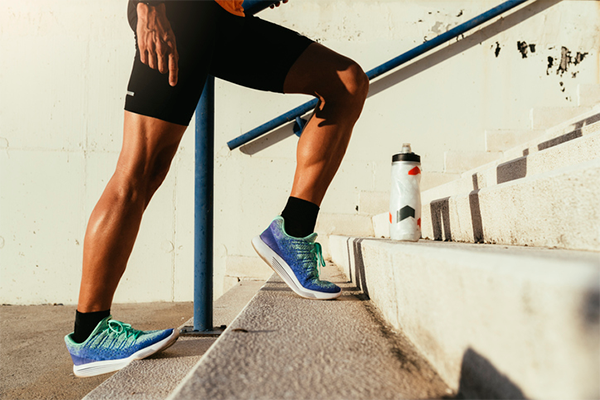
You probably know someone who has massive, sharply defined calf muscles, yet rarely exercises. Meanwhile, you’ve been calf training three times a week and still only see minimal results. What gives?
“Genetics play a role in your muscle makeup and size due to the allocation of Type I (slow-twitch) and Type II (fast-twitch) muscle fibers,” Kelley explains.
While Type I fibers are more resistant to fatigue, they tend to have a lower growth potential than Type II muscle fibers.
Everyone has a different percentage of Type I and Type II muscle fibers, meaning “someone with a genetic predisposition to Type II fibers may have a greater growth potential than someone who is more Type I dominant,” Kelley says.
If you weren’t born with naturally thick, shapely calves, don’t stress.
“[Genetic makeup] does not prevent anyone from increasing calf strength and size,” Braun says — it might just require more work.
The right high-intensity workout routine, diet, and recovery plan can help you build stronger, more athletic calves no matter where you’re starting from.
What to Eat to Build Bigger Calf Muscles
As with any muscle-building goal, smart nutrition is critical. So if you’re trying to build bigger calves (and an overall bigger lower body), you need to pay attention to what you eat.
“The proper amount of protein and amino acids to build muscle, carbs for energy, and supplementation with creatine and leucine can all be beneficial in calf hypertrophy,” Kelley says.
Focus on eating a balanced diet of lean protein (like chicken and fish), high-quality carbs (like fruit, veggies, and whole grains), and healthy fats (like avocado, salmon, and olive oil).
Stay on top of your hydration, too — as a general rule, aim to drink half your body weight in pounds in ounces each day.
Supplementation can also help you maximize your calf-building results. If you want an extra boost of energy before your calf workout, try Beachbody Performance Energize, which has beta-alanine and quercetin to delay exercise-induced muscle fatigue and help you push through those last few sets.
And don’t forget to refuel after your workout with a post-workout shake like Beachbody Performance Recover, which is designed to help facilitate protein synthesis (muscle growth) and speed your recovery.
It contains 20 grams of high-quality protein to feed your muscles, plus pomegranate extract to help reduce muscle soreness.
